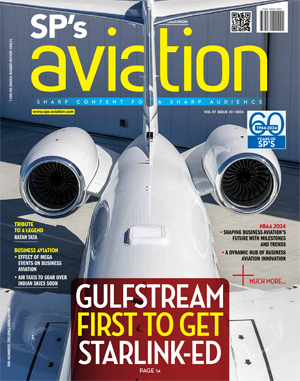INDIAN ARMED FORCES CHIEFS ON OUR RELENTLESS AND FOCUSED PUBLISHING EFFORTS

SP Guide Publications puts forth a well compiled articulation of issues, pursuits and accomplishments of the Indian Army, over the years

"Over the past 60 years, the growth of SP Guide Publications has mirrored the rising stature of Indian Navy. Its well-researched and informative magazines on Defence and Aerospace sector have served to shape an educated opinion of our military personnel, policy makers and the public alike. I wish SP's Publication team continued success, fair winds and following seas in all future endeavour!"

Since, its inception in 1964, SP Guide Publications has consistently demonstrated commitment to high-quality journalism in the aerospace and defence sectors, earning a well-deserved reputation as Asia's largest media house in this domain. I wish SP Guide Publications continued success in its pursuit of excellence.
General Aviation - It’s a Long Haul

Though nascent, the general aviation market in India is expected to grow at 10 per cent per annum to cross Rs. 1,600 crore by 2017 with operators acquiring about 300 business jets, 300 small aircraft and 250 helicopters
It is a known fact that the aviation sector plays an important role in the overall economic development of a country. In India, it is only of late that the aviation sector is getting a lot more importance as the nation looks at multi-modal transportation as a key enabler of economic activity. As India gets connected rapidly, it opens up opportunities like never before. The aviation sector is going through growth pangs. Air traffic has been growing at a robust 12-18 per cent per year in the last decade and with the government initiating several reforms, including allowing foreign direct investment (FDI), the sector is expected to catapult itself to the next level. Going by such anticipated growth trends, aircraft manufacturing companies; airport operators, airliners and other stakeholders have started looking anew at the opening up of opportunities.
For instance, Boeing has revised its estimates upwards to 1,450 airplanes India may require by 2031. In the next 10 years, domestic air traffic is expected to touch 160-180 million passengers per annum, while international traffic will exceed 80 million passengers from the current level of 60 million domestic and 40 million international passengers respectively. The International Air Transport Association has forecast that India’s domestic air travel market between 2012 and 2016 would be among the top five globally, experiencing the second highest growth rate.
While these figures may appear encouraging, there are niggling issues that are affecting the industry, such as that of the woes of Kingfisher Airlines and Air India, both failing badly because of management issues. Aviation turbine fuel will continue to dog airlines for a long time to come, particularly in India.
Uncertainty prevails
The Centre for Asia Pacific Aviation (CAPA) has said Indian aviation is facing its most uncertain phase in more than a decade. After reporting an estimated record loss of just over $2 billion ( Rs. 10,000 crore) for year ending March 31, 2012, it said Indian carriers were up for another challenging year ahead. Weak balance sheets, increasing costs, regulatory uncertainty, a sluggish Indian economy and a difficult global environment will continue to pile the pressure on airlines, especially the poorer performing carriers. However, this may in turn create market opportunities to exploit for those that are better positioned.
In the financial year 2011-12, the growth was 15.1 per cent lower than what CAPA had forecast at 17 per cent, due to the slow down in the sector. However, the gain is for other airlines and with Indian carriers expecting to add some aircraft during 2012-13, the passenger demand can be met. CAPA estimates that this would result in capacity growth of 7-8 per cent in a best case scenario. This estimate may be revised downwards now that Air India has stopped operation of Dreamliner in the light of safety issues.
Pitching for Hub and spoke model
For the sustenance of this growth trajectory (particularly exponential domestic traffic), one of the identified contributing factors is the development of Indian airports as regional aviation hubs. A Ministry of Civil Aviation report has noted that Indian airports have the potential of extracting significant hub traffic from its regional competitors, given its natural growth of traffic and geographical positioning of India.
Currently, in the absence of a good Indian hub, major portion of the international hub traffic is routed through other regional hubs such as Dubai, Doha, Bangkok, Singapore and Frankfurt by their respective hub carriers, which have direct access to several Indian airports. For instance, in the year ending March 2011, transfer traffic under this category was 15 million passengers per annum (mppa), but Indian carriers accounted for only 14 per cent of this traffic. Hence, there is a significant opportunity for the Indian carriers and airports to gain traffic in this segment by offering a more competitive product.
In the domestic to domestic segment too, the figures are dismal. For the year ending March 2011, approximately 2.7 mppa of such passengers were transferred and the prime reason for such low traffic is the relatively short travel time (2-3 hours) which makes a stopover disadvantageous. However, as and when the airlines connect to Tier-II and Tier-III cities, this opportunity could scale up.
The main reason for the poor market share of Indian carriers in both international and domestic traffic segments is that India is just waking up to the concept of hub development whereas foreign airports and airlines have had a good lead; financial strength and fleet size of Indian carriers is poor as compared to that of competing airlines such as Emirates, Singapore and Lufthansa; operational costs (due to aircraft turbine fuel and taxation) are high in India; and legacy processes at Indian airports dampen international traffic movement.





